engine coolant MITSUBISHI 3000GT 1991 Owner's Manual
[x] Cancel search | Manufacturer: MITSUBISHI, Model Year: 1991, Model line: 3000GT, Model: MITSUBISHI 3000GT 1991Pages: 1146, PDF Size: 76.68 MB
Page 126 of 1146
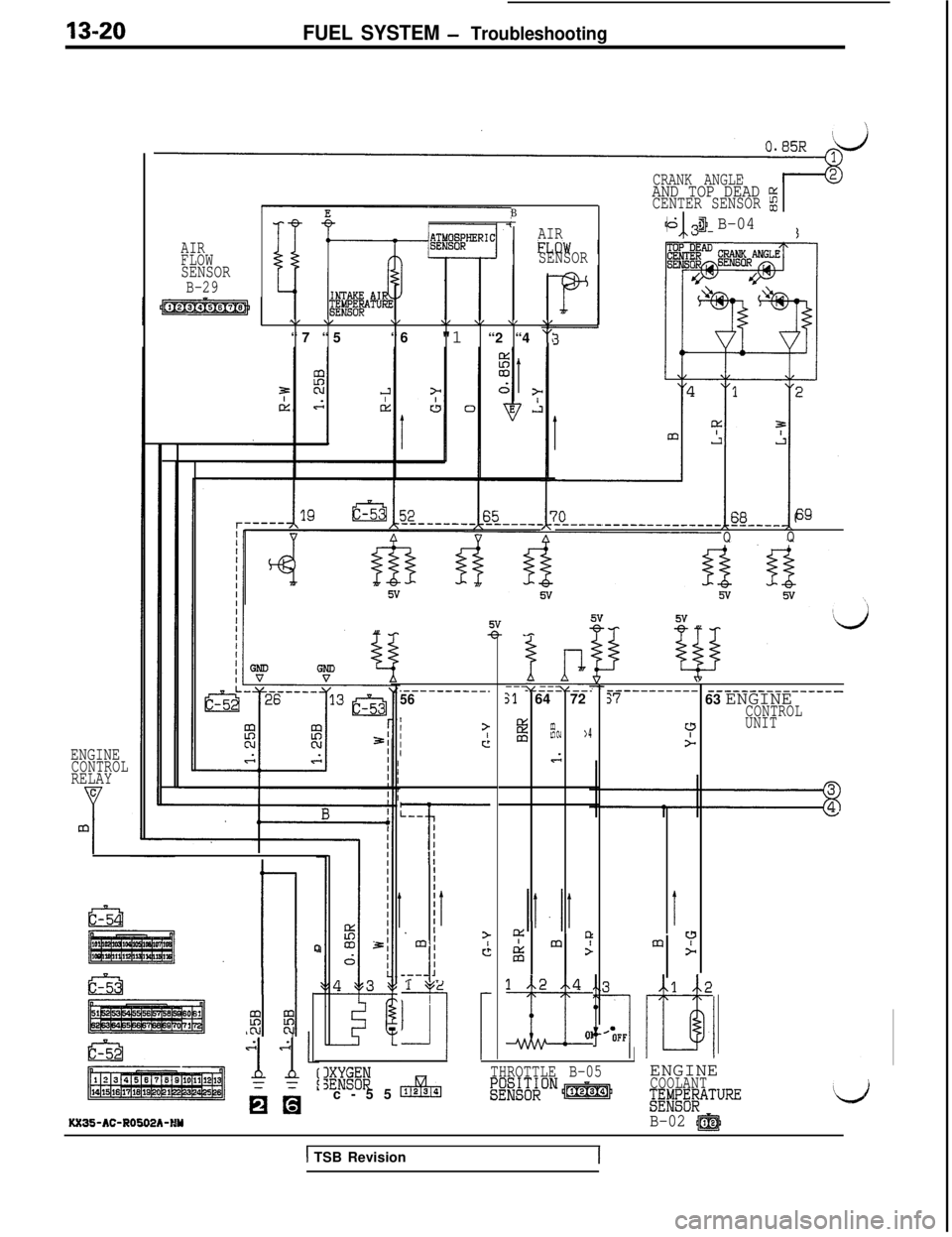
13-20FUEL SYSTEM - Troubleshooting
CRANK ANGLEAND TOP DEAD z
BCENTER SENSOR $j
AIR4-j B-04613
SENSOR
\/ v\/\, \I \/\I“7 “5“6
"1 “2 “4 “l
AIR
FLOW
SENSORB-29
69
QQ
ip--------.Sl6472
4:g$w cu> 4
d
m95
”----------- __---------_____:763 ENGINECONTROL?UNIT>
I
m?>
.----------.56
III?IcIENGINECONTROLRELAYc
Y
mL--I
1;
III
jr
I>ml
-II
d
--- 11 2
I
~~
12 4
~01
Ii%ml
c-55
c&m
THROTTLE B-05ENGINE
~~~Q~~oNp&q+COOLANT$E!E$BATURELj
B-02 @J
.h
0
I I
$I I$KX35-AC-R0502h-HY
1 TSB Revision
Page 128 of 1146
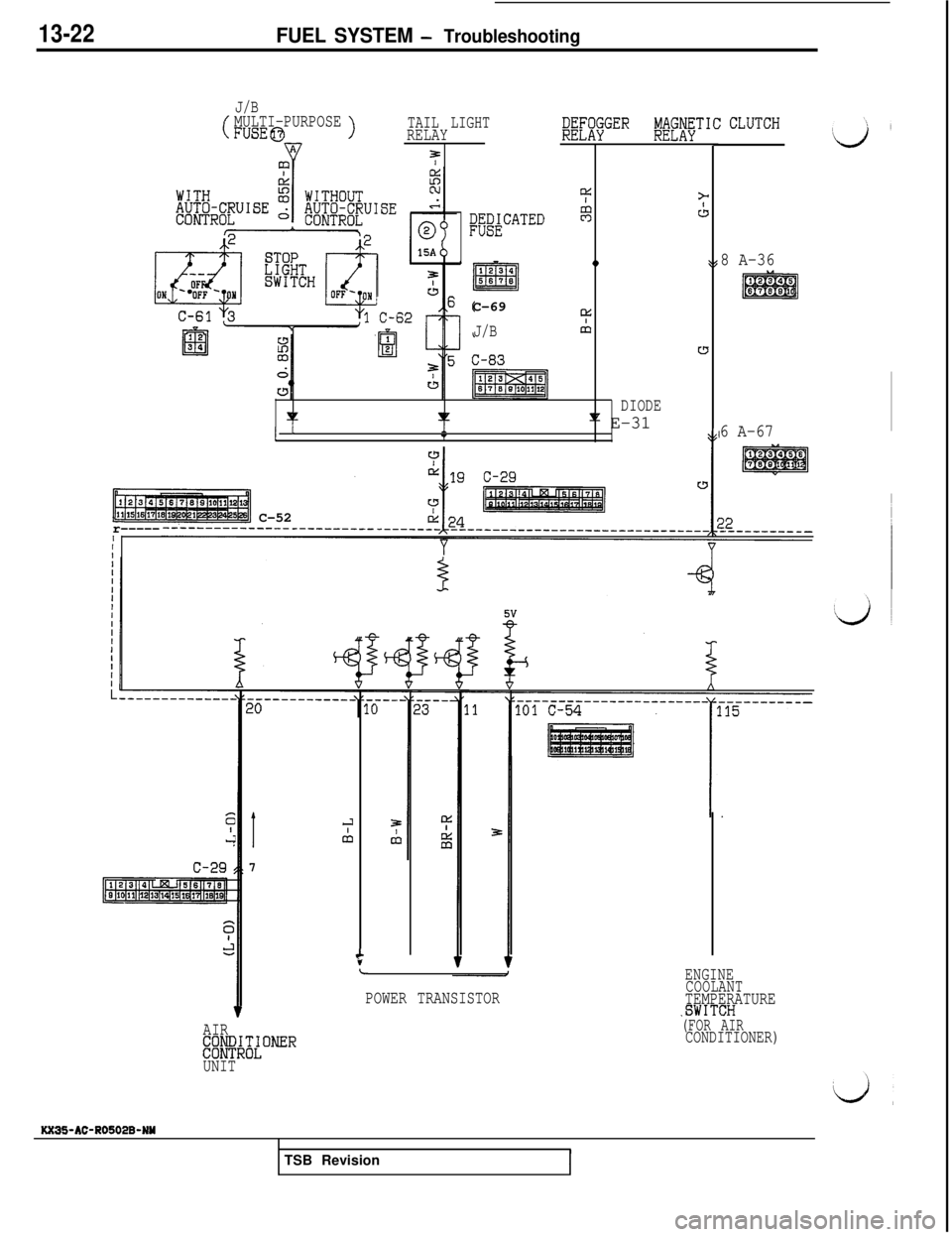
13-22FUEL SYSTEM - Troubleshooting
J/B
(MULTI-PURPOSEFUSE@>TAIL LIGHTRELAYiE;;FGER ikli$IC
5I7
>
;;iZ;CATED gJ
0\IC-69
[1:
J/B&I
w
8 A-36
7
DIODE*Ire E-31I ’1IT6 A-67C-52
r-----IY
6I1
J
CA
7
.i
tc
POWER TRANSISTOR
ENGINE
COOLANT
TEMPERATURE.SWITCH
(FOR AIR
CONDITIONER)AIR~X$Il$T~ONER
UNITKX35-AC-R05025-NY
TSB Revision
Page 135 of 1146
![MITSUBISHI 3000GT 1991 Owners Manual FUEL SYSTEM - Troubleshooting13-29
ENGINE
CONTROL
RELAYF
1 7=2
c----IIIIIIII2,(2Io FUEL
) SE
PRESSURE
SOLENOID
VALVE
IfII
I
I
I
I
J
]i#&B,D i
A-20
1
WASTE
GATE
SOLENOIDVALVE
/
7 EGRi ~XE~~OID
I
; A-21 MITSUBISHI 3000GT 1991 Owners Manual FUEL SYSTEM - Troubleshooting13-29
ENGINE
CONTROL
RELAYF
1 7=2
c----IIIIIIII2,(2Io FUEL
) SE
PRESSURE
SOLENOID
VALVE
IfII
I
I
I
I
J
]i#&B,D i
A-20
1
WASTE
GATE
SOLENOIDVALVE
/
7 EGRi ~XE~~OID
I
; A-21](/img/19/57085/w960_57085-134.png)
FUEL SYSTEM - Troubleshooting13-29
ENGINE
CONTROL
RELAYF
1 7=2
c----IIIIIIII2,(2Io FUEL
) SE
PRESSURE
SOLENOID
VALVE
IfII
I
I
I
I
J
]i#&B,D i
A-20
1
WASTE
GATE
SOLENOIDVALVE
/
7 EGRi ~XE~~OID
I
; A-21
L
1 A-70
j A-72
f ENGINEj jXICI$ROL
I
-------13s
3.------
s
10
/\1
>
J
c
”-_-
1 A-18
3P
~;~E&DIAGNOSIS #Fjhl;;ON
CONNECTORADJUSTMENT
EFfq&@gCONNECTOR
d
Efpggggg]
I B-OS
ENGINE
COOLANT
Q&;EEATURE ,,'I/\FOR AIR)/@ICONDITIONEROFF --xOlJ
POWER STEERING;tK;BESSURETSB Revision
Page 137 of 1146
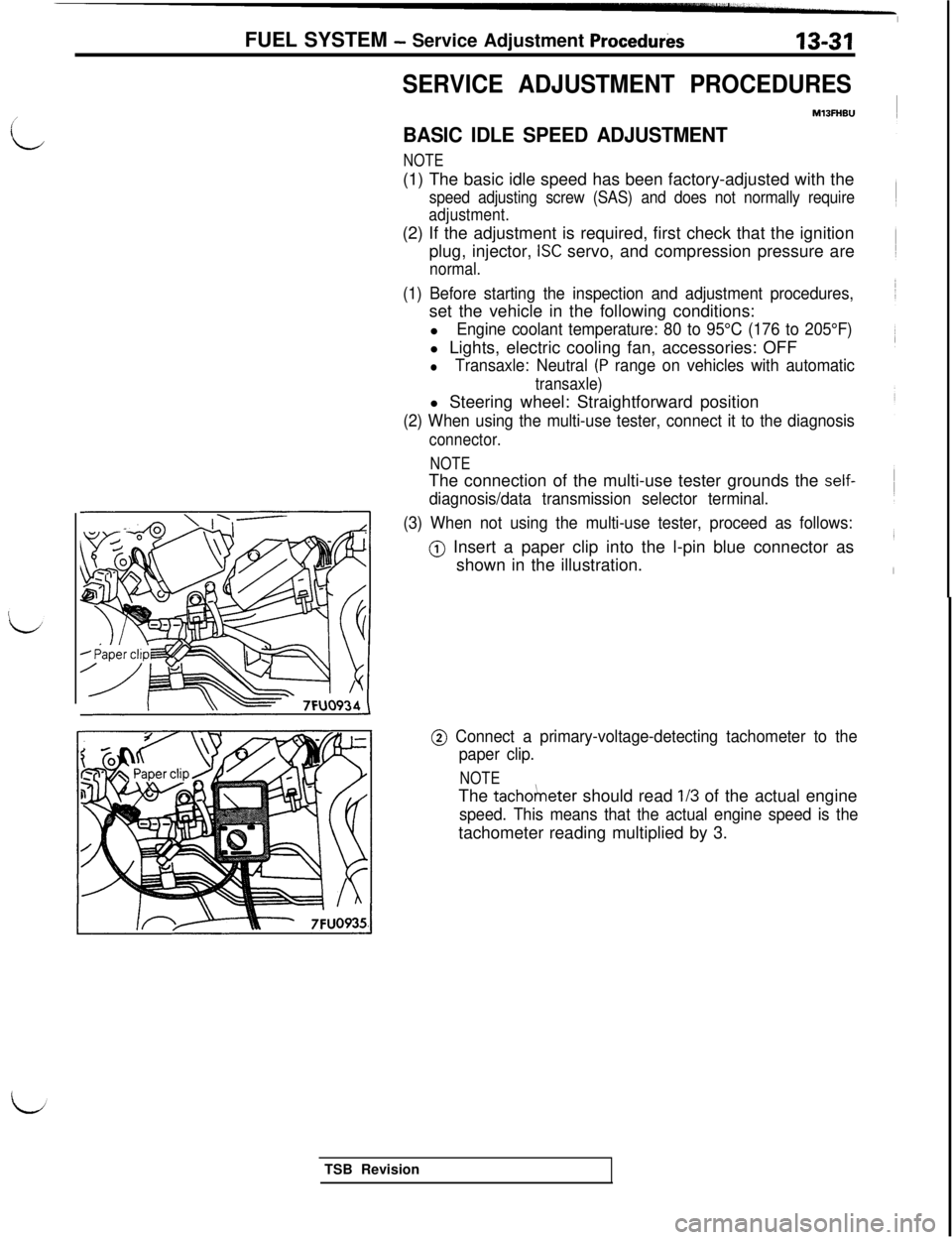
SERVICE ADJUSTMENT PROCEDURES
MlBFHSU
BASIC IDLE SPEED ADJUSTMENT
NOTE(1) The basic idle speed has been factory-adjusted with the
speed adjusting screw (SAS) and does not normally require
adjustment.(2) If the adjustment is required, first check that the ignition
plug, injector,
ISC servo, and compression pressure are
normal.
(1) Before starting the inspection and adjustment procedures,set the vehicle in the following conditions:
l
Engine coolant temperature: 80 to 95°C (176 to 205°F)l Lights, electric cooling fan, accessories: OFF
lTransaxle: Neutral (P range on vehicles with automatic
transaxle)l Steering wheel: Straightforward position
(2) When using the multi-use tester, connect it to the diagnosis
connector.
NOTEThe connection of the multi-use tester grounds the
self-
diagnosis/data transmission selector terminal.
(3) When not using the multi-use tester, proceed as follows:
@) Insert a paper clip into the l-pin blue connector as
shown in the illustration. FUEL SYSTEM
- Service Adjustment Procedurks13-31
i
@ Connect a primary-voltage-detecting tachometer to the
paper clip.
NOTEThe
tacho/neter should read l/3 of the actual engine
speed. This means that the actual engine speed is thetachometer reading multiplied by 3.
TSB Revision
Page 139 of 1146
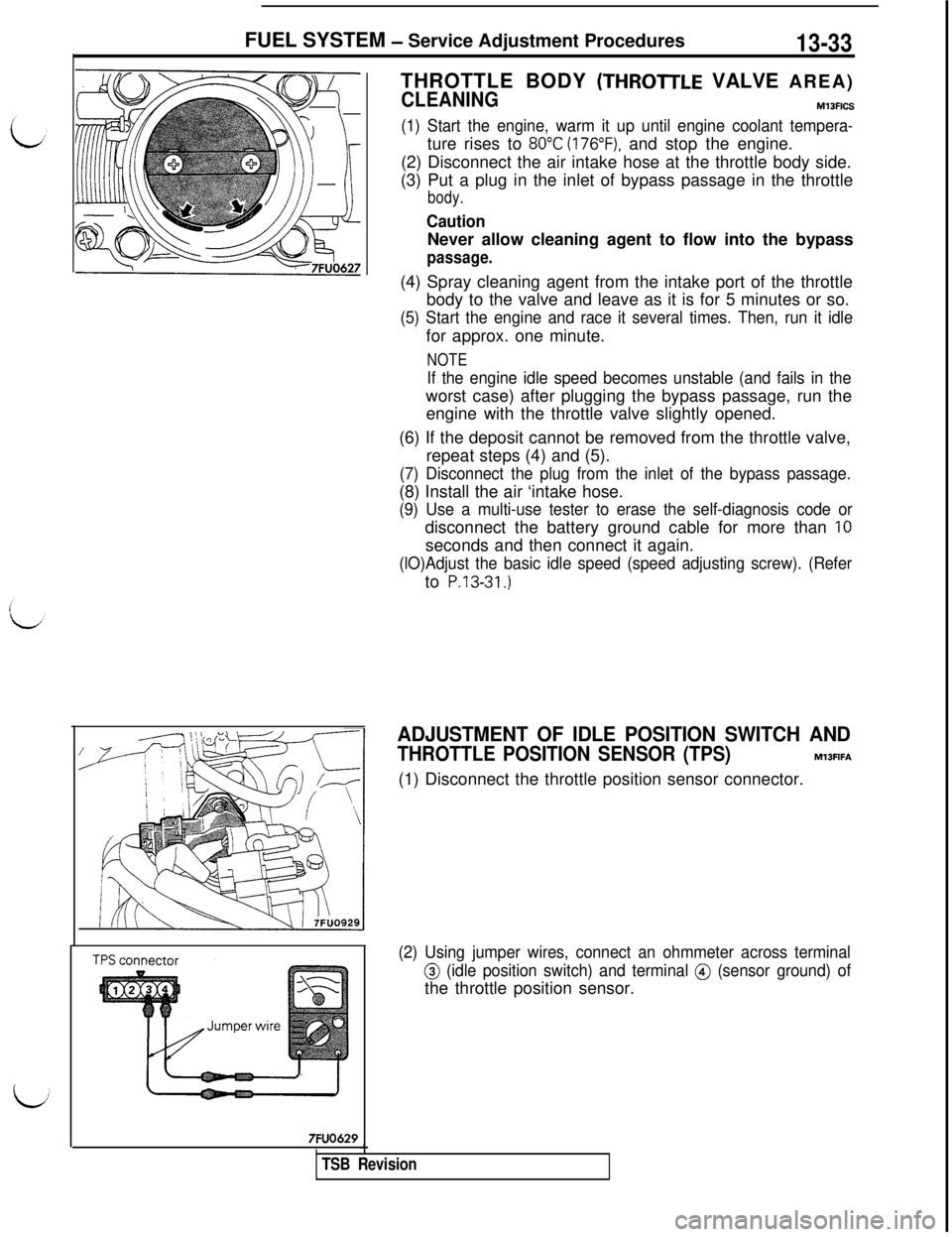
FUEL SYSTEM - Service Adjustment Procedures13-33THROTTLE BODY
(THROTrLE VALVE AREA)
CLEANINGM13FICS
(1) Start the engine, warm it up until engine coolant tempera-ture rises to
80°C (176”F), and stop the engine.
(2) Disconnect the air intake hose at the throttle body side.
(3) Put a plug in the inlet of bypass passage in the throttle
body.
CautionNever allow cleaning agent to flow into the bypass
passage.(4) Spray cleaning agent from the intake port of the throttle
body to the valve and leave as it is for 5 minutes or so.
(5) Start the engine and race it several times. Then, run it idlefor approx. one minute.
NOTE
If the engine idle speed becomes unstable (and fails in theworst case) after plugging the bypass passage, run the
engine with the throttle valve slightly opened.
(6) If the deposit cannot be removed from the throttle valve,
repeat steps (4) and (5).
(7) Disconnect the plug from the inlet of the bypass passage.(8) Install the air ‘intake hose.
(9) Use a multi-use tester to erase the self-diagnosis code ordisconnect the battery ground cable for more than
IOseconds and then connect it again.
(lO)Adjust the basic idle speed (speed adjusting screw). (Referto
P.13-31.)
7FUO629
ADJUSTMENT OF IDLE POSITION SWITCH AND
THROTTLE POSITION SENSOR (TPS)M13FIFA(1) Disconnect the throttle position sensor connector.
(2) Using jumper wires, connect an ohmmeter across terminal
@ (idle position switch) and terminal @ (sensor ground) ofthe throttle position sensor.
TSB Revision
Page 142 of 1146
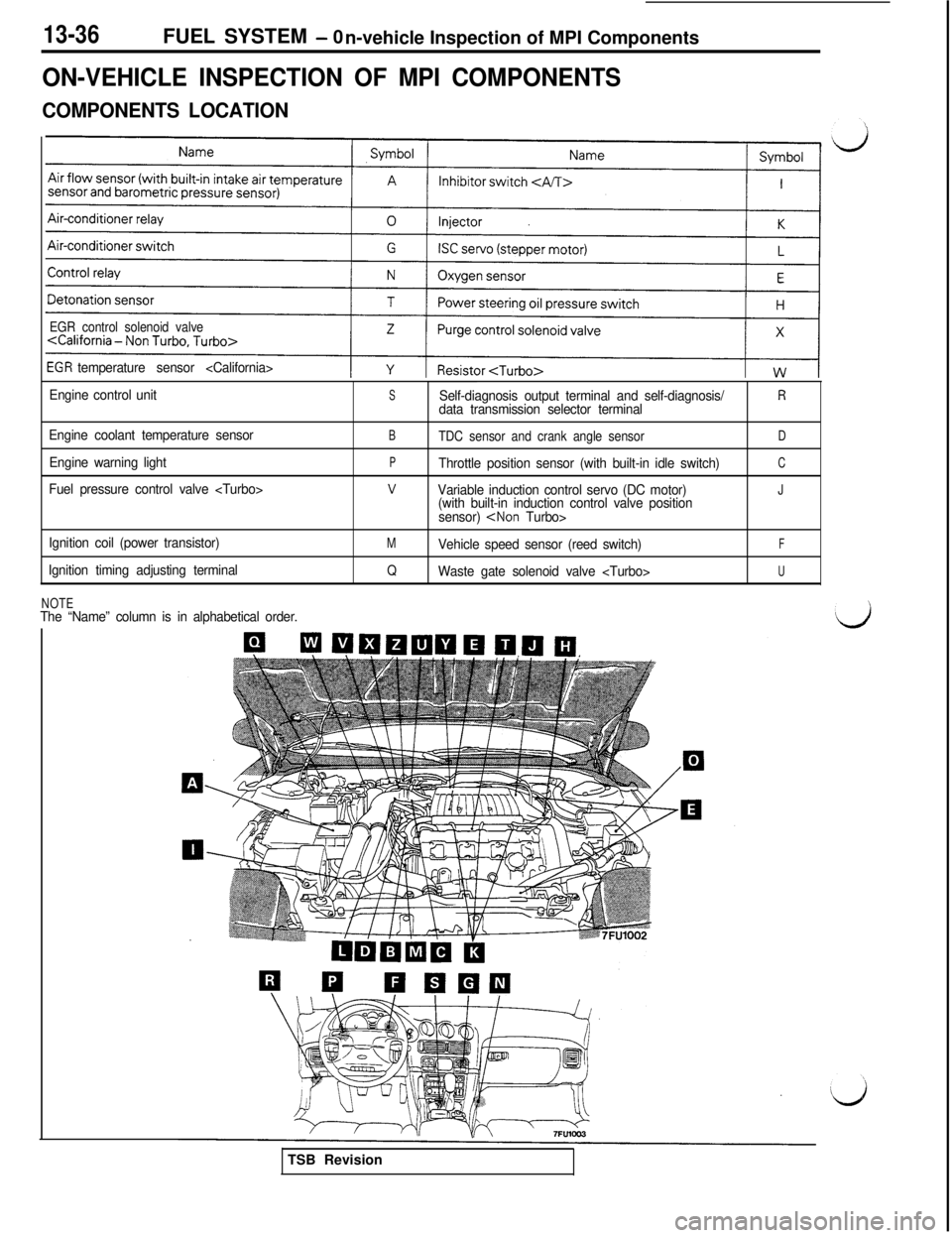
13-36FUEL SYSTEM - 0
n-vehicle Inspection of MPI Components
ON-VEHICLE INSPECTION OF MPI COMPONENTS
COMPONENTS LOCATION
EGR control solenoid valve
temperature sensor
Engine control unit
Engine coolant temperature sensor
Engine warning light
Fuel pressure control valve
Ignition coil (power transistor)
Ignition timing adjusting terminal
SSelf-diagnosis output terminal and self-diagnosis/Rdata transmission selector terminal
BTDC sensor and crank angle sensorD
PThrottle position sensor (with built-in idle switch)C
vVariable induction control servo (DC motor)J(with built-in induction control valve position
sensor)
MVehicle speed sensor (reed switch)F
QWaste gate solenoid valve
NOTEThe “Name” column is in alphabetical order.TSB Revision
Page 161 of 1146

FUEL SYSTEM - On-vehicle Inspection of MPI Components13-55
INSPECTIONUsing Multi-use Tester
Function
Data readingtern No. Data display
12Sensor airvolume(frequency)
Check conditionEngine stateStandard value
l Engine coolant tem-
700 rpm (Idle)25-50 Hzperature: 80 to 95°C
(176 to 205°F)2,000 rpm70-IOOHzl Lights and accessories:OFFRacingFrequency increasesl Transaxle: Neutralwith racing(P range for vehiclewith AIT)l Steering wheel: Neutral
NOTEWhen the vehicle is new [within initial operation of about 500 km (300 miles)], the air flow sensor output frequency maybe about 10% higher.
Function
Data listItem No. Data displayCheck conditionsEngine conditionsStandard value
34Reset signall Engine warm up700 rpm (Idle)ON
condition2,000 rpmOFF
L;
FunctionItem No. Data display
Data list37Volumetric
efficiencyCheck conditionEngine stateStandard valuel Engine coolant tem-700 rpm (Idle)20-35%
perature: 80 to 95°C
(176 to 205°F)
l Lights, electric cooling2,000 rpm15-30%
fan and accessory opera-tion: OFFl Transaxle: NeutralRacingFrequency increases
(P range for vehiclewith racingwith &T)
l Steering wheel: Neutral
Using Oscilloscope(1) Run the engine at idle speed.
(2) Connect the probe to the oscilloscope pick-up point as
shown in the circuit diagram, and check the waveform.
Regular waveform
03A0203
TSB Revision
Page 168 of 1146

13-62FUEL SYSTEM- On-vehicle Inspection of MPI Components
ENGINE COOLANT TEMPERATURE SENSORM13Ybu2
1
If
il\__ ;I\*
Coolant temperature
162458Coolant temperaturei67im-m
Coolant temperature sensor
@ Equipment side
connector
2
fi
I
Engine control unit ), 72A63
1 ff35V
7FUO667
OPERATION
lThe engine coolant temperature sensor converts the engine coolant temperature into a voltage and inputsit to the engine control unit, which then controls the fuel injection rate and fast idle speed when the
engine is cold based on the input signal.
l The 5 V power in the engine control unit is supplied via a resistor in the unit to the engine coolant
temperature sensor. Through the sensor which is a kind of resistor, it is grounded in the engine control
unit. The engine coolant temperature sensor resistor has such characteristic that its resistance decreasesas the coolant temperature rises.
lThe engine coolant temperature sensor terminal voltage increases or decreases as the sensor resistance
increases or decreases. Therefore, the engine coolant temperature sensor terminal voltage changes withthe coolant temperature, decreasing as the temperature rises.
TROUBLESHOOTING HINTS
If the fast idle speed is inadequate or the engine emits dark smoke during engine warm up operation, theengine coolant temperature sensor is often faulty.
TSB Revision
Page 169 of 1146
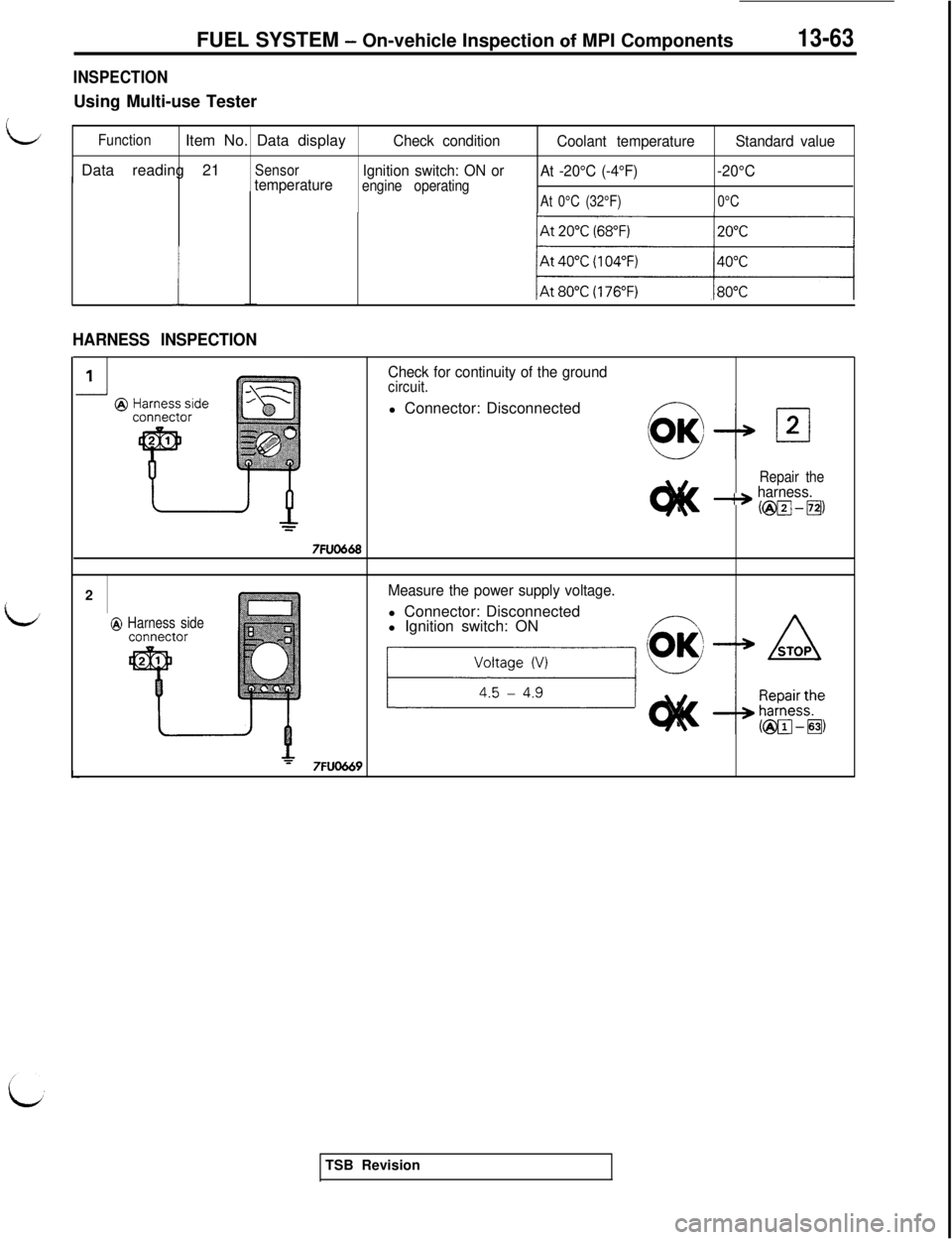
id
LFUEL SYSTEM
- On-vehicle Inspection of MPI Components13-63
INSPECTIONUsing Multi-use Tester
LFunctionItem No. Data displayCheck condition
Coolant temperatureStandard valueData reading 21
SensorIgnition switch: ON or
At -20°C (-4°F)-20°C
temperatureengine operatingAt 0°C (32°F)0°C
HARNESS INSPECTION
Check for continuity of the groundcircuit.l Connector: Disconnected
Repair the---+ harness.
7FUO6682
Measure the power supply voltage.l Connector: Disconnected
@ Harness sidel Ignition switch: ON
7FUO669TSB Revision
Page 170 of 1146
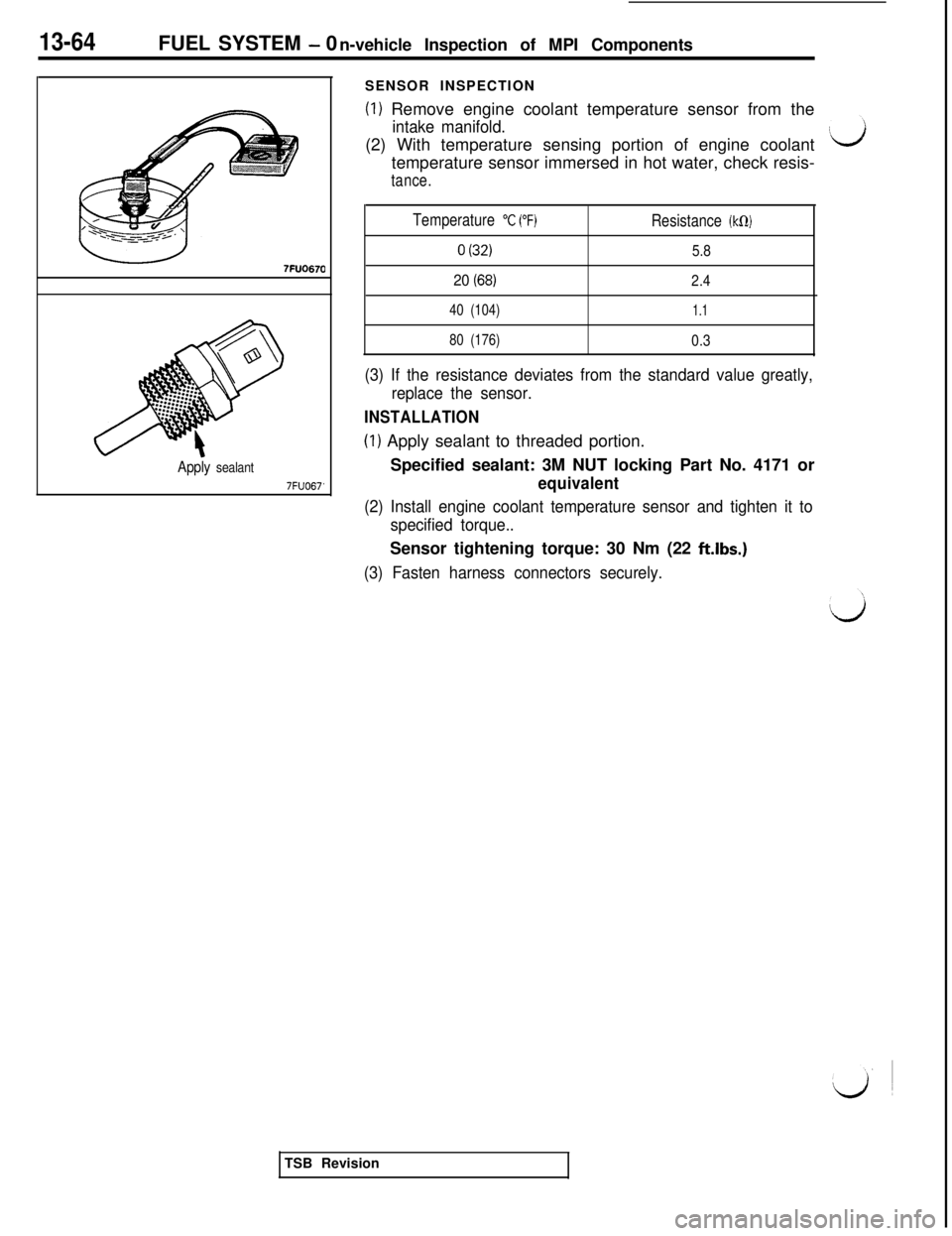
13-64FUEL SYSTEM - 0
n-vehicle Inspection of MPI Components
7FUO670
Apply sealant
7FUO67’SENSOR INSPECTION
(1) Remove engine coolant temperature sensor from the
intake manifold.(2) With temperature sensing portion of engine coolant
temperature sensor immersed in hot water, check resis-
tance.
Temperature
“C (“F)Resistance (kCI)
0 (32)5.8
20 (68)2.4
40 (104)1.1
80 (176)0.3
(3) If the resistance deviates from the standard value greatly,
replace the sensor.
INSTALLATION
(1) Apply sealant to threaded portion.
Specified sealant: 3M NUT locking Part No. 4171 or
equivalent
(2) Install engine coolant temperature sensor and tighten it to
specified torque..Sensor tightening torque: 30 Nm (22
ft.lbs.)
(3) Fasten harness connectors securely.TSB Revision